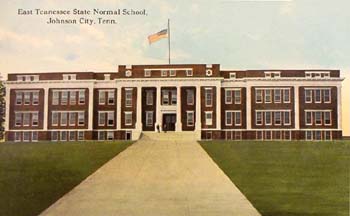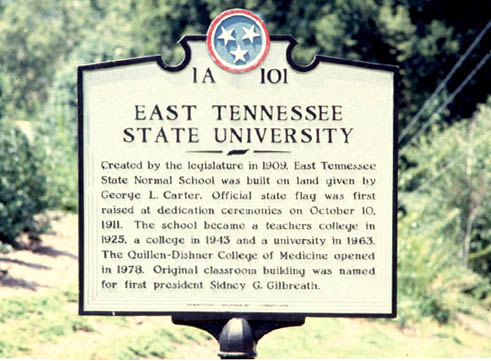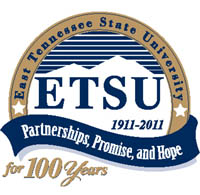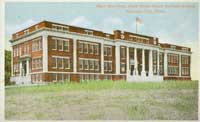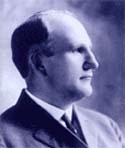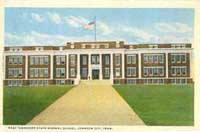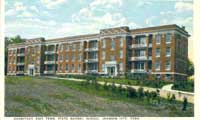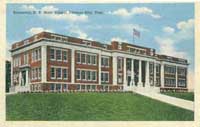A somewhat archaic term, "Normal Schools" were training schools for primary teachers. The concept originated in Europe and gained popularity in the U.S. during the nineteenth century. The term used a secondary definition of the word "normal" which referred to "model" or "pattern". The word "normal" can be defined as: Conforming with, adhering to, or constituting a norm, standard, pattern, level, or type; typical.
Normal school - "A school whose methods of instruction are to serve as a model for imitation; an institution for the training of teachers." Normal schools typically offered a 2-year course of instruction.
As would be expected, after approval by the Tennessee General Assembly in 1909, intense competition began by the cities bidding for one of the three normal school sites authorized. Some fascinating accounts exist relating to the founding of East Tennessee State University as retold by our favorite publication: the Johnson City Comet and faithfully reprinted here at Johnson's Depot. Was Comet Editor Cy Lyle a good presenter or not? You be the judge. The man could certainly write great news stories.
At the close of the Civil War, advocacy for the establishment of state normal schools accelerated in Tennessee. A tandem movement was also underway to establish a state system of public schools which became law in 1873. However, funding languished for pubic education statewide and only limited progress was made prior to 1900. Many influential citizens generally used private schools and did not see a public school system as a priority.
Around 1900 teachers in Tennessee's public schools were certified by local authorities and no established educational criteria existed. The great majority of teachers were not only without college training but also without high school training. Ability to pass an examination by the local authorities was the only qualification to teach. An average teacher salary of slightly over $130 a year and a school term of only 93 days also are indicative of the state of affairs. In 1903, 78% of Tennessee's public school teachers held third grade certificates, implying no training for their work rather than a common education. Very limited opportunities were available beyond the 4- week "institute courses" offered in many counties to prepare and train Tennessee's teachers.
By an act of the General Assembly in 1909, the State Board of Education was authorized to establish three normal schools for the training of white teachers, one in each grand division of the state, and an agricultural and industrial normal school for black students. Since counties and municipalities were authorized by law to issue bonds for establishment and location of the normal schools, competition was keen among the cities statewide to be selected for a new school. The state had made no financial appropriation to pay for land and limited funding for buildings requiring the cities to make aggressive bids to be submitted to the State Board of Education.
Along with Johnson City, Sweetwater, Athens and Dayton were finalists for the East Tennessee Normal School site. Johnson City's offer was by far the most aggressive in East Tennessee. Johnson City and Washington County each pledged $75,000 in bonds, free land was offered, free utilities including electricity and water, and a street car line would be extended to serve the new campus. Cy Lyle, Editor of the Johnson City Comet made Johnson City's case for the school accompanied by a distinguished delegation from the "Queen City" - apparently Johnson City was called this at the time.
|
Johnson City Comet, December 2, 1909 Johnson City gets the State Normal for East Tennessee. The decision was reached by the State Board of Education Wednesday noon, after being in session since Monday morning. The joyful news reached Johnson City by wire immediately and every whistle in the city was dampened with steam and the lusty throated songsters conveyed the glad tidings to the community and the rejoicing was "above Normal." |
Two Johnson City sites were evaluated for the Normal School: one in Carnegie (East Johnson City) and a second in south Johnson City across from the National Soldiers Home. George L. Carter, founder of the Clinchfield Railroad was developing hundreds of acres in south Johnson City in his "Carter Addition" that included residential areas (Tree Streets) and industrial properties (Model Mill) and the Normal School was seen as a major enhancement for his developments. To seal the deal with Governor Patterson and the Board of Education, Carter bought property to round out the campus in the middle of the night and began construction of a road. For the great "railway builder of the Appalachians," this was not an out of character event as George L. Carter was not known to be outbid when he set out to secure a project.
The original campus included five buildings - the administration building, the President's home, the women's dormitory, the dining hall, and the heating plant. Sidney Gilbreath was the first President of East Tennessee Normal School. The Normal School led by Gilbreath certainly performed as intended as Mr. Gilbreath aggressively promoted teacher education and boldly supported the case for public education throughout East Tennessee. Sidney Gilbreath may have also had an entrepreneurial spirit as evidenced by the following report from the Johnson City Comet:
| Johnson City Comet, February 16, 1911 CITY WILL LET OUT HIGH SCHOOL The City Board of Education has signed a contract with the State Board of Education to have the city high school taught for the next two years in the State Normal School. The school law provides that city boards may contract with the state board to have all of the public school grades taught in the normal schools as observation and practice schools. This arrangement will give our boys and girls the full benefit of a modern high school course, including manual training, domestic science, agriculture, and a first-class commercial course. This is an advantage that our people should appreciate and take advantage of. It is now costing the city more than $4,500 to maintain the high school and the cost of having the high school taught at the State Normal for the next two years is $4,000 a year. This is considerably less than it is now costing. The street car line will be extended to the Normal School right away. The material has been ordered and work is to begin in a few days on the track. The Normal School will likely open not later than the first of next November. The high school will be taught at Science Hill by the Normal teachers until the opening of the Normal School. The schools are to be congratulated on this forward movement. |
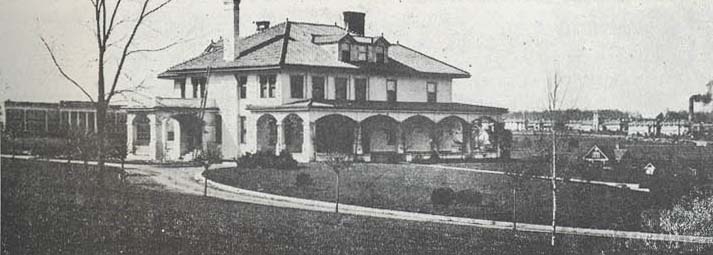 |
|
View showing George L. Carter's home in foreground, new Normal
School buildings in left of photo, and National Soldiers Home in the distance on the right George L. Carter Family - 1900 Photo Below: George L. Carter with his "Model Mill" |
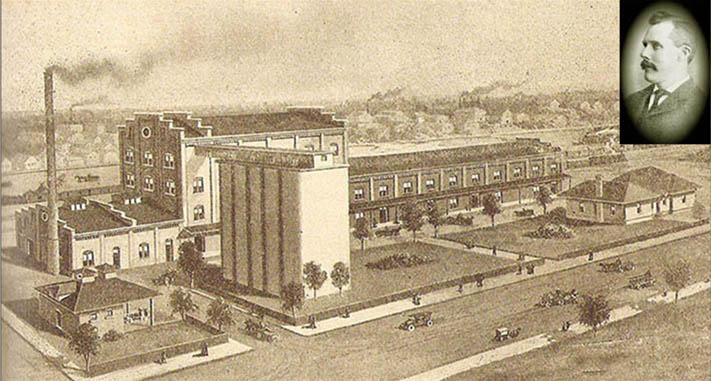 |
The Normal School had a full public school or training school on its campus that still operates today as the University School. The economic benefit and cultural impact on Johnson City as well as the impetus for teacher education throughout East Tennessee from the Normal School cannot be calculated.
Unlike the 2-year construction period funded by the U.S. government that built the National Soldiers Home campus, the Normal School was constructed gradually by state appropriations as evidenced by the aerial photos shown on this page. Contrast the view from the National Soldiers Home in 1909 with the aerial view of the area in 2000.
|
Historical Marker Denoting ETSU Campus |
|
|||||||||||||||||||||||||||||||||||||||||||||||
|
|||||||||||||||||||||||||||||||||||||||||||||||
|
Links
|
|||||||||||||||||||||||||||||||||||||||||||||||
